America’s White Saviors
White liberals are leading a ‘woke’ revolution that is transforming American politics and making Democrats increasingly uneasy with Jewish political power




A sea change has taken place in American political life. The force driving this change is the digital era style of moral politics known as “wokeness,” a phenomenon that has become pervasive in recent years and yet remains elusive as even experts struggle to give it a clear definition and accurately measure its impact. Where did it come from? What do its adherents believe? Is it just something happening inside the Twitter bubble and on college campuses or is it really spreading across the social and cultural landscape and transforming the country as sometimes appears to be the case? In reality, “wokeness”—a term that originated in black popular culture—is a broad euphemism for a more narrow phenomenon: the rapidly changing political ideology of white liberals that is remaking American politics.
Over the past decade, the baseline attitudes expressed by white liberals on racial and social justice questions have become radically more liberal. In one especially telling example of the broader trend, white liberals recently became the only demographic group in America to display a pro-outgroup bias—meaning that among all the different groups surveyed white liberals were the only one that expressed a preference for other racial and ethnic communities above their own. As woke ideology has accelerated, a growing faction of white liberals have pulled away from the average opinions held by the rest of the coalition of Democratic voters—including minority groups in the party. The revolution in moral sentiment among this one segment of American voters has led to a cascade of consequences ranging from changes in the norms and attitudes expressed in media and popular culture, to the adoption of new political rhetoric and electoral strategies of the Democratic Party. Nor has this occurred in a vacuum on the left as the initiatives set in motion by white liberals have, in turn, provoked responses and countermeasures from conservatives and Republicans.
In a recent Vox article based partly on the dissertation research I’ve been doing as a Ph.D. candidate in political science at Georgia State University, Matthew Yglesias described this ongoing transformation as “The Great Awokening.” In Yglesias’ account: “In the past five years, white liberals have moved so far to the left on questions of race and racism that they are now, on these issues, to the left of even the typical black voter. This change amounts to a ‘Great Awokening.’” There is no simple or single explanation for how this process got started. It appears to be driven by an interplay of factors: preexisting tendencies among white liberals; a series of polarizing events like the police shooting of Michael Brown and subsequent riots in Ferguson, and the migrant crisis; the rise of millenials as a political force, and the explosion of social media and “woke” clickbait journalism. The years between 2012 and 2016 were a watershed for white liberal racial consciousness. But the seismic attitudinal shifts of those years have implications that go beyond race: They are also tied to a significant decrease in support for Israel and—perhaps more surprisingly—a rise in the number of white liberals who express negative attitudes about the perceived political power of American Jews.
As white liberals have come to place far greater emphasis on racial injustice, they have also endorsed reparative race-related social policies in greater numbers. This is evident across a range of issues: the rapid growth in white liberals who favor affirmative action for blacks in the labor force; in the increase in white liberals who feel that we spend too little on helping blacks, and that the government should afford them special treatment; in the increase in white Democrats who think it’s the government’s job to ensure “equal income across all races”; and in the increase in white liberals and Democrats who think that white people have ‘too much’ political influence.
At the same time, there are growing levels of support for policies without such obvious connections to race. For instance, between 1965 and 2000, the percentage of white liberals preferring increased immigration levels never deviated far from 10%. From the mid-2000s to roughly the end of President Obama’s term in office, this figure gradually ascended into the 20-30% range. As of 2018, it sits at over 50%. Then, there is the marked shift in attitudes toward Israel. Between 1978 and 2014, white liberals consistently reported sympathizing more with Israel than the Palestinians. Since March of 2016, this trend has turned on its face: Significantly more white liberals now report greater sympathy for the Palestinians than for Israel.
Some of these changes arguably stem from Trump’s rhetoric and policies on immigration. But a glance at the data shows that, as with their attitudes toward blacks, the percentage of white liberals perceiving “a lot” or “a great deal” of discrimination against immigrants more than doubled between 2000 (29%) and 2013 (57%)—i.e., well before Trump arrived on the scene. Additionally, between 2006 and 2014, the percentage of white liberals saying they feel “very sympathetic” toward illegal immigrants and their families grew from 22% to 42%.
For the woke and their allies, these rapid changes are heralded as signs of progress, leading at times to harsh criticism of anyone who would stand in their way. This ideological stridency and triumphalist attitude can be powerful weapons against political opponents but are alienating—perhaps deliberately so—to moderates and conservatives. But, in a sense, no one is put in a more strained and problematic position by the politics of white liberals than the white liberals themselves. The woke elite act like white saviors who must lead the rest of the country, including the racial minorities whose interests they claim to represent, to a vision of justice the less enlightened groups would not choose for themselves.
Consider, for instance, that black and Asian Democrats and liberals are significantly more supportive of restrictive immigration policies and less positive toward racial/ethnic diversity than their white counterparts. Black and Hispanic Democrats and liberals are more sympathetic toward Israel than the Palestinians (likely due in part to the fact that they tend to be more religious). They are also more likely to part ways when it comes to contemporary social and gender-identity issues, including views of the #MeToo movement. In all, though they do converge on some issues, the attitudes and policy preferences of the woke white left are unrepresentative of the “marginalized communities” with whom they are supposed to be allies. And as woke liberals play a leading role in party politics, the Democrats, who are increasingly defined by their embrace of diversity and progressive stances on issues of racial justice, appear to do so, at least partly at the direction of a small white elite.
To understand the motivations behind the “great awokening” we must first review some of the basics of political psychology. Social scientists use a model called “The Big Five personality traits” or “five-factor model” to describe how the relative prevalence of key character traits—extroversion, agreeableness, openness, conscientiousness, and neuroticism—shapes an individual’s political orientation. A large body of work in this field consistently finds that liberals score significantly higher than conservatives on the personality trait “agreeableness” and more specifically on its sub-dimension of “compassion.” In social science studies like these, agreeableness represents the tendency to be altruistic, tender-minded, cooperative, trusting, forgiving, warm, helpful, and sympathetic. The trait is closely linked with empathy and compassion toward the suffering of others. However, the relative lack of agreeableness in conservatives doesn’t meant they don’t care about the suffering of others. Rather, it suggests that liberals have a broader scope of empathy. Compared to conservatives who prioritize the well-being of the in-group—family, local community, or nation—liberals show relatively greater concern for the plight of out-groups, if not the world as a whole.
Closely related to agreeableness are the moral foundations of “harm/care” (e.g., “whether or not someone suffered emotionally”) and “fairness” (e.g., “whether or not some people were treated differently than others”). Moral Foundations Theory argues that ideological differences derive from the weight people ascribe to a core group of moral considerations: harm/care, fairness/cheating, loyalty/betrayal, authority/subversion, sanctity/degradation, and liberty/oppression. A substantial line of research reveals that, out of these moral considerations, liberals generally attach the most importance to the foundations of harm/care and fairness. While conservatives also tend to rate these foundations as important, their moral compass is broader and includes a greater concern for violations of purity (e.g., “whether or not someone was able to control his or her desires”), loyalty (e.g., “whether or not someone did something to betray his or her group”), and authority (e.g., “whether or not someone respected the traditions of society”). As with empathy, the liberal concern for harm/care and fairness relates to a larger set of targets (e.g., animals, the needy in other countries) than it does for conservatives, who are generally more concerned with threats to the in-group. The liberal conception of ‘harm’ is also far broader, which lowers the threshold at which their moral alarms are triggered.
An example of how these psychological characteristics and moral foundations can be manifested in politics and policy can be seen in the graph below, which shows white responses to measures of empathy toward racial and ethnic minorities.
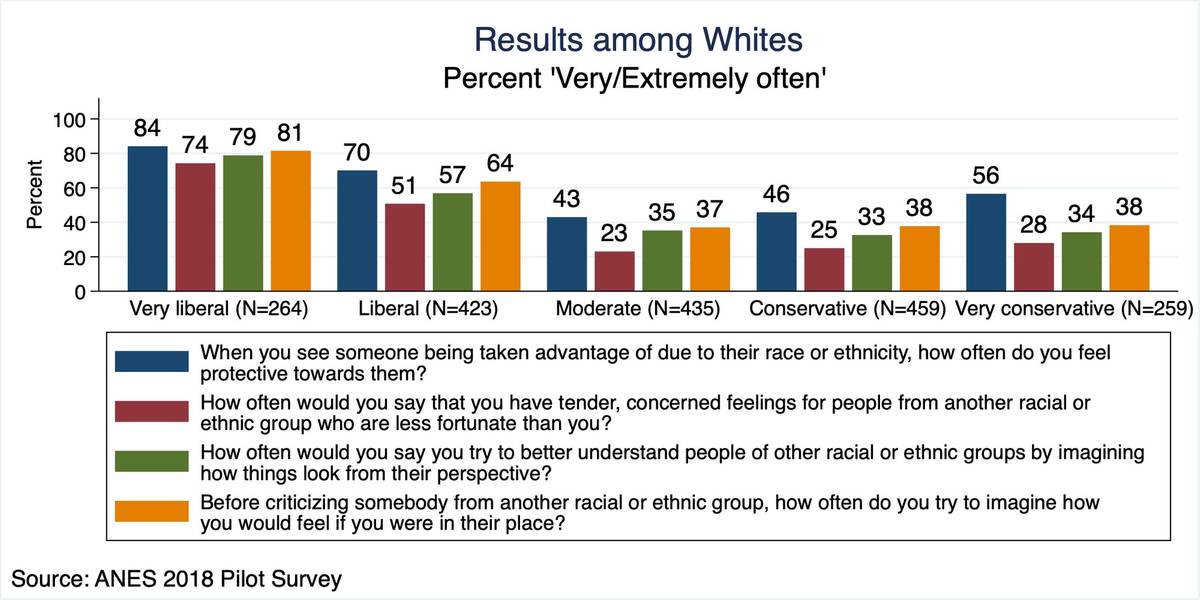
As the graph above shows, white liberals—especially the self-identified “very liberal”—are significantly more likely to report intense or extremely frequent feelings of tenderheartedness, protectiveness, and sensitivity when considering the circumstances of racial and ethnic out-group members. A related graph below displays the average differences in feelings of warmth (measured along a 0-100 scale) toward whites vs. nonwhites (i.e., Asians, Hispanics, and blacks) across different subgroups.
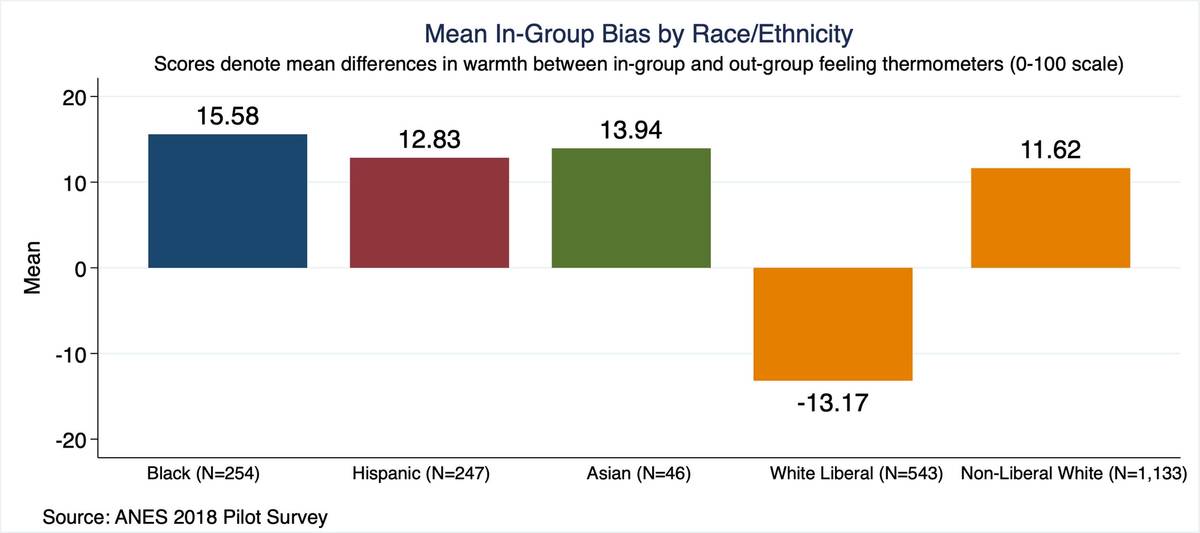
Remarkably, white liberals were the only subgroup exhibiting a pro-outgroup bias—meaning white liberals were more favorable toward nonwhites and are the only group to show this preference for group other than their own. Indeed, on average, white liberals rated ethnic and racial minority groups 13 points (or half a standard deviation) warmer than whites. As is depicted in the graph below, this disparity in feelings of warmth toward ingroup vs. outgroup is even more pronounced among whites who consider themselves “very liberal” where it widens to just under 20 points. Notably, while white liberals have consistently evinced weaker pro-ingroup biases than conservatives across time, the emergence and growth of a pro-outgroup bias is actually a very recent, and unprecedented, phenomenon.
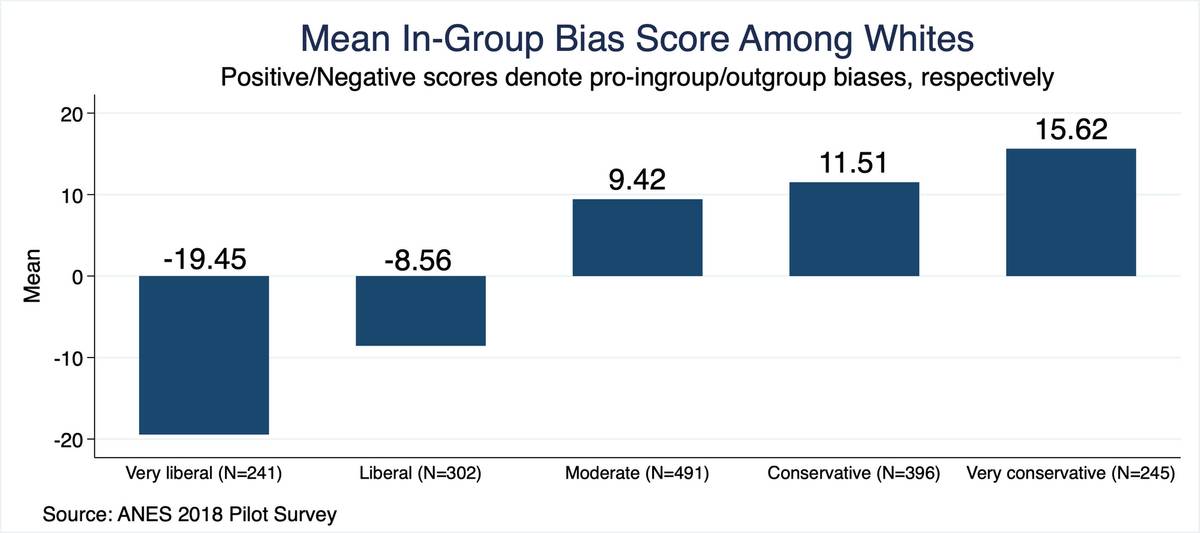
Not surprisingly, data from the American National Elections Studies (ANES) shows white liberals scoring significantly higher on measures of ‘white privilege awareness’ (e.g., ‘how much does being white grant you unearned privileges in today’s society?’) and ‘white guilt’ (e.g., ‘how guilty do you feel about the privileges and benefits you receive as a white American?’). Both of these variables are strongly correlated with measures of liberal racial sympathy (or what is more traditionally referred to as ‘low racial resentment’)–the white liberal scores on which reached an ANES-high in 2016. Previous research has shown that these collective moral emotions, triggered by historical wrongdoing and perceptions that an in-group’s advantages and privileges are illegitimate, can can increase support for reparative and humanitarian social policies. That is exactly what has happened in recent years as white liberals have become increasingly supportive of affirmative action, reparations, and increased immigration.
For most of human history, the primary trigger for moral emotions like outrage came from local acts of wrongdoing. After all, if you have no idea what events are going on outside your village and hardly any sense of the world at large, it’s hard to be outraged by them. In the modern era, however, this is rapidly becoming less true. Along with drastic improvements in material well-being, which, some argue, has enabled individuals whose immediate needs are met to shift their to concern to the welfare of people they’ve never met—modern technology has widened our exposure to injustices against strangers. The diffusion of the internet, social media in particular, has enabled people from across the globe to document and upload their every moral grievance. In a recent study, respondents reported experiencing significantly greater exposure to immoral acts and expressed greater moral outrage online vs. in person or through traditional media platforms (newspaper, TV, radio, etc.). Meanwhile, other recent research finds that morally “outrageous” content is retweeted, shared, and commented on more frequently than all other material in circulation. And with algorithms tracking what you click on so as to direct you to similar stimuli in the future, political social media consumers are being fed a steady supply of outrage.
Data from the General Social Survey reveals a roughly 170% increase in the number of weekly hours, from 5 to 13.6, that people reported spending on the internet between 2000-2018. Between 2006 and 2018, the percentage of respondents listing the internet as their primary news source jumped roughly 33 percentage points from 14.2% to 47.6%. Turning to social media, data I pooled from the Pew Research Center shows a similar increase in the percentage of people reporting social media use between 2008-2016, from 34.8% to 73%. These increases have occurred among all whites, regardless of political affiliation, but not to the same degree. White liberals place ahead of conservatives on every one of these measures of internet use and social media exposure. They spend significantly more weekly hours on the internet; are significantly more likely to list the internet as their primary news source; and significantly more likely to consume news from and be politically active on social media. A 2016 Pew Racial Attitudes survey further shows that of the 74% of white liberals (vs. 55% of white conservatives) reporting social media use, roughly 44% (vs. 30% of white conservatives) say that at least some of the posts are about race or race relations. And, more generally, 70% of white liberals (vs. 51% of white conservatives) report discussing race relations or racial inequality with others either “sometimes” (39%) or “often” (31%).
An analysis of GoogleTrends data, graphed below, shows that the frequency of searches for race-related and “woke” terms has grown substantially since the beginning of the decade—a period that happens to coincide with the social media boom and the emergence of so-called hashtag activism (e.g., Occupy Wall Street, Black Lives Matter). This period also saw the rise of the Huffington Post—an online progressive blog and news site that prolifically opines on race-related issues. Whereas just 13% of white liberals reported regularly visiting the site in 2012, over 30% did in 2016. A similar pattern is observed for digital readership of The New York Times (NYT), which grew from 16% to 31% among white liberals between 2012 and 2016—during this same period, according to a recent content analysis I conducted—the percentage of Times articles mentioning race-related and woke terms saw unprecedented growth. For instance, whereas just 0.4% (or 334) of articles referred to racism in 2012, this figure had doubled by 2015 (to 0.87% or 813) and reached over 2% (or 2,353) by 2018. Interestingly, the number of monthly NYT articles mentioning racism also closely tracks Google search interest in the term.
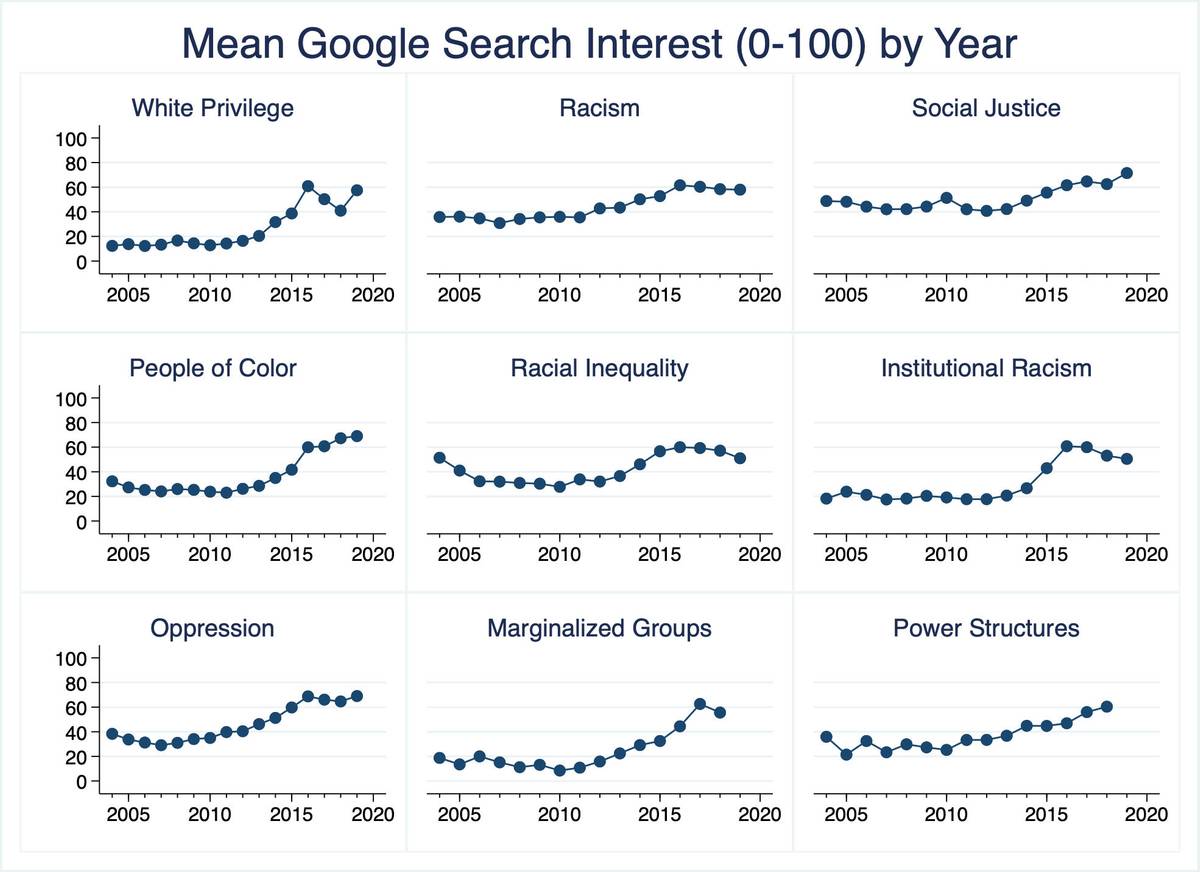
Thus, by all indications, the first half of this decade appears to have been a watershed for white liberal racial consciousness. The picture that emerges from the various points of data is one in which white liberals and social media created a kind of outrage feedback loop. White liberals started spending ever increasing shares of their time in a medium—social media and internet news sites—at the same moment that, for multiple reasons, that medium produced a higher volume of race-related moral outrage stories relative to other forms of journalism. Exposure to the stories on those sites, in turn, generated moral outrage among white liberal readers who then fed that emotional response back into the sites, which catered to their appetites as consumers, thus powering the feedback loop. Liberals tend to have an “unjust world bias” as it is; but digital media ensures that this disposition is frequently reinforced.
One way that constant media exposure can warp people’s perception of reality is by leading them to overestimate the danger from certain threats. For instance, research shows that frequent and vivid exposure to crime-related media increases perceptions of the prevalence of crime and police racism. Other more limited work points to a relationship between Twitter use and the perceived prevalence of school shootings. This tendency to overestimate the prevalence and significance of things we are frequently exposed to and thus more easily able to recall is known as the availability heuristic. As a cognitive shortcut for quickly arriving at judgments the availability heuristic can be a useful adaptation in some circumstances but misleading in others. It means, for example, that if videos of white-on-black police shootings or other instances of discriminatory behavior are circulating on Twitter, people may perceive such incidents to be far more common than they actually are and, consequently, that white society is more prejudiced than it actually is.
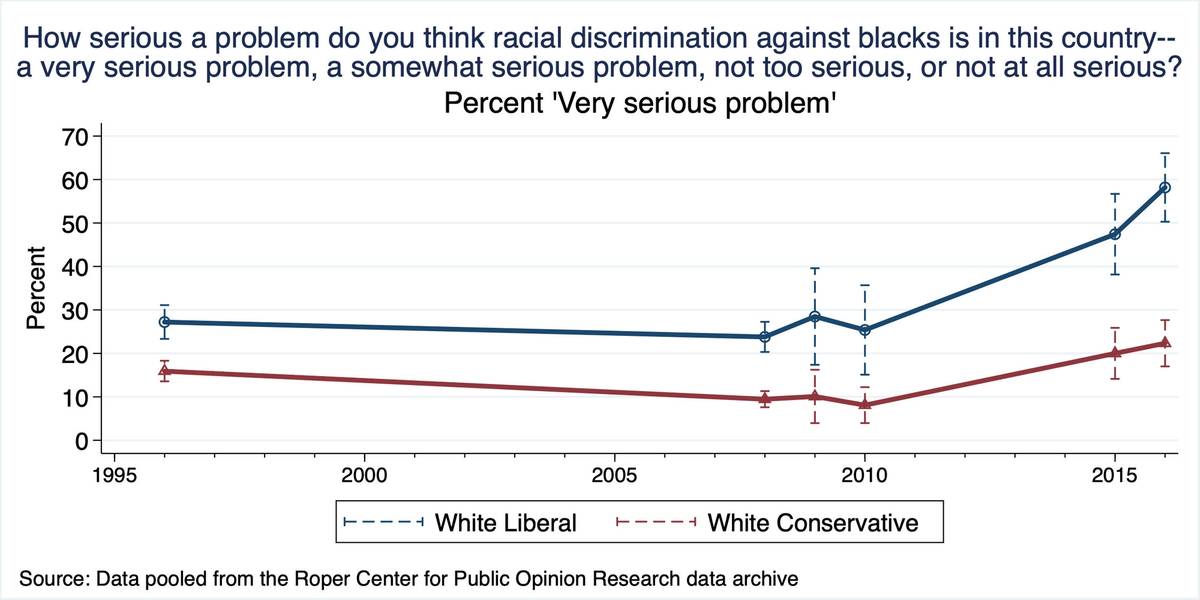
The graph above shows the percentage of white liberals and conservatives perceiving discrimination against blacks to be a “very serious problem.” Although data was unavailable for the intervening years, the percentage of white liberals giving the “very serious” response was largely the same in 2010 (25%) as it was in 1996 (27%). By 2015, however, this figure had almost doubled to 47%, and then increased further to 58% in 2016. Responses to more specific questions are consistent with this trend. When participants asked whether the criminal justice system is biased against blacks, a white liberal in 1995, 2000, and 2007 was just as likely to think that blacks were treated fairly as unfairly. By 2014, the proportion saying “biased against” soared upward to 70%, while those saying “treated fairly” fell to 20%. Likewise, the percentage of white liberals who felt that whites and blacks have an equal chance of getting ahead in life was in the 50-60% range between 2000 and 2010. In 2011, the percentage giving this response suddenly plummeted to under 40%, while the proportion saying “white people” became the new majority. In contrast, the percentage of white conservatives giving the “equal” response changed very little (and in the positive direction; 62.7%→64.4%). And while the number of black respondents with this view fell significantly (40.8%→20.1%), it quickly and mostly rebounded just a year later (34%). White liberals, on the other hand, moved south and never turned back.
To determine the extent to which these trends are powered by the rise of digital media and hashtag activism will require more robust and longitudinal studies. But the evidence that’s currently available suggests a direct relationship between a person’s level of social media activity and their perception of how prevalent discrimination is. The February 2016 Pew Racial Attitudes survey cited earlier shows that white liberals who report that some or most of the content they see on social media is race-related, perceive significantly greater mistreatment of blacks than those reporting no or only a little exposure to race-related content. Other data shows that white liberals who get most of their news online are significantly more likely to “strongly disagree” that racial problems in the United States are “rare, isolated situations,” when compared to people, including other white liberals, who primarily consume printed or televised local news.
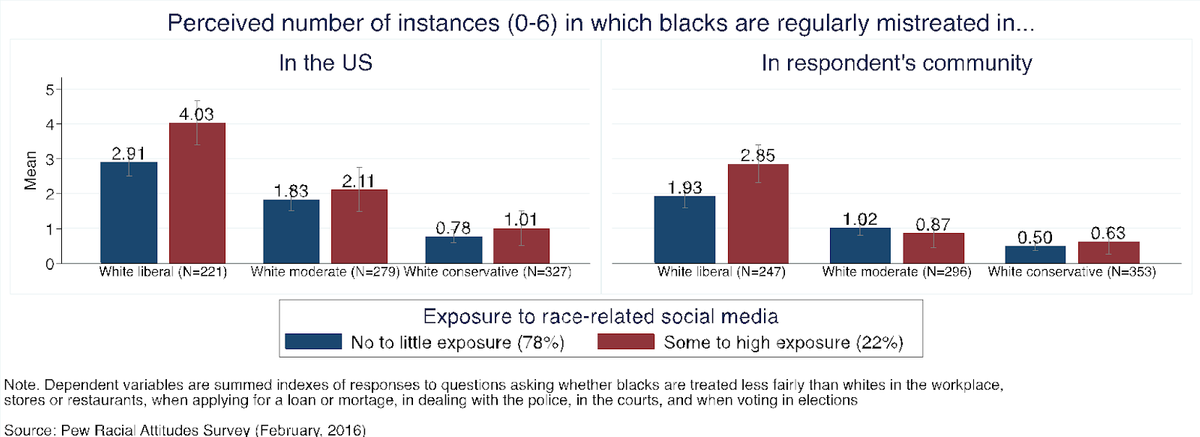
Along with the sweeping changes on race and immigration issues is the reversal of white liberal attitudes toward Israel. Between 1978 and 2014, white liberals consistently reported sympathizing more with Israel than the Palestinians. Since March of 2016, this trend has turned on its face. Currently, significantly more white liberals report greater sympathy for the Palestinians than for Israel.
The sudden souring of white liberal attitudes towards Israel bears some resemblance to the rapid attitudinal changes on racial issues. Like the police shootings of unarmed blacks during this period, Israel’s 7-week bludgeoning of Gaza became arguably the most extensive of its military campaigns to be captured on social media. It was also the campaign that drew the least support from White liberals. Consider that 65% of White liberals felt that Israeli actions during the 2002 ‘Operation Defensive Shield’ were justified. Although This figure declined to 47% during Operation Cast Lead (2009), it largely stayed there (46%) during Operation Pillar of Defense (2012). But by the time Operation Protective Edge rolled around less than two years later, the percent viewing Israeli actions as justified dipped to a low of 30%—the lowest level of support in two decades, if not ever. At around the same time, Google searches for topics relating to ‘Anti-Zionism’ reached a high point in August of 2014—the closing month of Israeli military operations. While a decline is also observed among white conservatives—dropping from 78% in 2012 to 65% in 2014—that represents a relatively minor drop from the 72% of white conservatives who supported Israel’s military operations in 2002.
To be sure, white liberals continue to express favorable views of Jews. What’s different today is that their sympathy toward and concern for Jews has become more conditional. To understand why, consider how white liberals responding to an Associated Press poll last year ranked various groups in America in terms of their relative advantage or disadvantage.
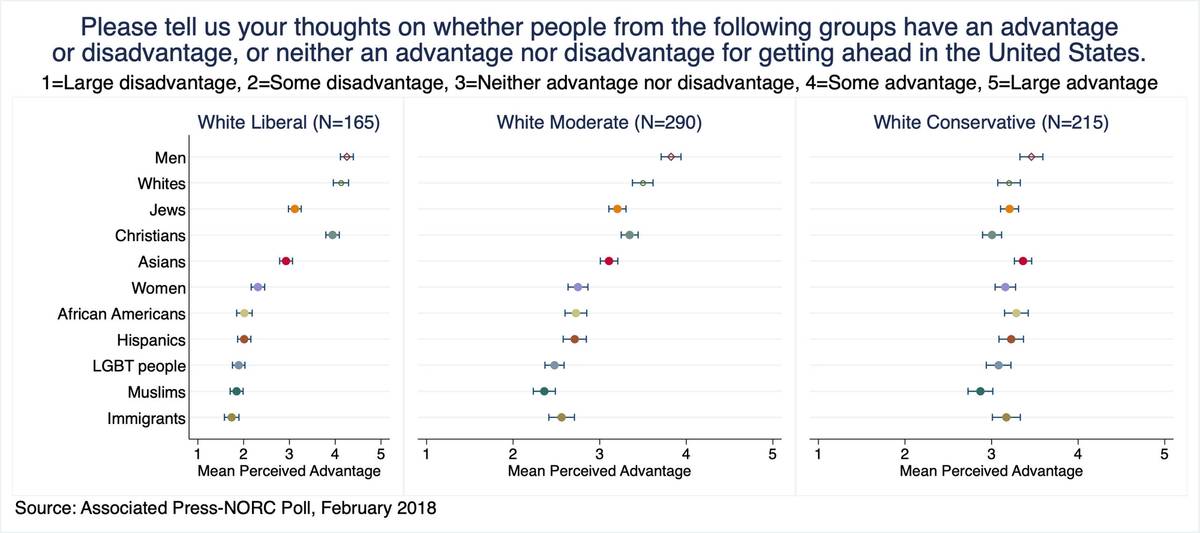
The surveys show that among white liberals, Jews are perceived to be privileged—at least in comparison to other historically victimized groups. Having made a full recovery from the Holocaust, Jews are no longer the downtrodden collective that white liberals can readily sympathize with. Other groups lower on the privilege hierarchy and less tainted by association with whiteness now have priority. So long as anti-Semitism has a white face to it, there is no problem here. But if the face is actually that of a member from an “oppressed” or “vulnerable” group, there may be a cognitive dissonance.
To see how this logic extends to Israel consider that the same empathic outrage over the bigoted persecution by the “privileged” against the vulnerable that informs the changing policy positions on domestic issues is extended out to the international arena where Israel is a fixture of every moral drama. A white supremacist America holds people of color down and keeps the door shut for others, while a “Zionist supremacist” Israel behaves in much the same way toward its minorities of color. It’s a narrow and warped perspective but one that’s easily assimilated into a broader worldview in which human relations are defined by categories of oppressor vs. oppressed; and where the roles are assigned based on one’s placement in the privilege hierarchy. A recent study found that informing or reminding white liberals of their privilege resulted in reduced sympathy for poor whites relative to blacks. As Jews have become beacons of whiteness in the liberal political imagination—to the point that Israel is considered a white state despite having a slight nonwhite majority—they have come to be associated with an oppressor class. We shouldn’t be surprised then that white liberals are significantly more likely to feel that Jewish groups have “too much influence” and less likely to say the same with respect to their Muslim counterparts.
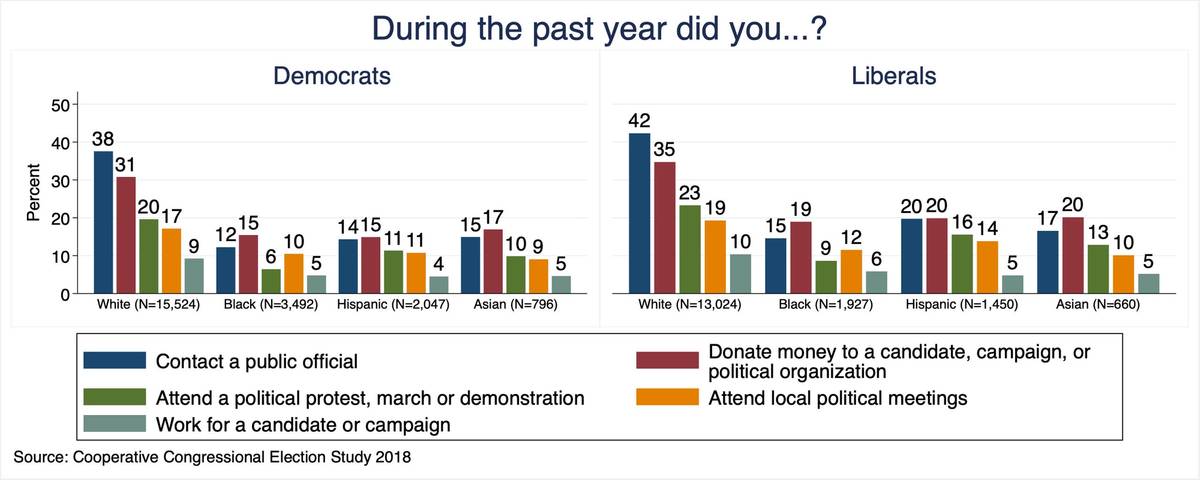
A wealth of research shows that elected officials are most responsive to the voices (and campaign contributors) they hear from the most; and, by many measures, white liberals and Democrats are the most politically active group on their side of the partisan aisle. White liberals make up 20-24% of the general population but, for a multitude of reasons, exert an outsize political and cultural influence. They are more likely to consider themselves activists, are more active on social media, and, significantly, they are one of the most affluent groups in the country. Of course, small groups of vocal and determined minorities can drive positive changes and spur social progress. The danger is that “woke” white activists acting on behalf of voiceless minorities have had their perceptions distorted by social media-tinted caricatures that obscure more objective measures of reality and end up silencing or ignoring what the voiceless groups, themselves, have to say about what policies are in their best interest.
To point this out is not an indictment of white liberals as a group or of the moral psychology that drives them. Nor is it an endorsement of conservatism. To the contrary, the moral emotions that liberals are more apt to feel, such as guilt, empathy, and compassion are necessary for a just and healthy social order. They serve as a vital counterweight to the inclinations of the more in-group, and hierarchy-oriented conservative counterparts.
The problem is when these moral emotions become hyperactive and detached from objective reality; when they motivate the division of society into ‘allies’ and enemies; and when they generate a level of sanctimonious outrage and judgment that places all political dissent beyond the pale. The advent of digital and social media has fomented just such a carnival of excesses. It cultivates an image of the world soaked in the very oppression and injustices to which the user is most sensitive and attuned—and thus one that frequently triggers liberal moral alarms. There is no shortage of oppression and injustice in America and the wider world. But things are not nearly as bad nor as uniformly black and white as they appear on Twitter and YouTube feeds. Hispanics, Muslims, and other minorities do not leave their homes and enter a world where white racism greets them at every street corner. In fact, multiple recent studies find no racial disparities in police use of deadly force. The odds of an unarmed black person being shot by police appear to approximate his/her chance of being struck by lightning. The probability of being killed by a right-wing extremist is equally low, if not lower. Of course, violence committed by police officers or motivated by prejudice offends our sense of morality and violates our vision of a just society in a way that lightning strikes and other nonhuman events do not; but for this moral outrage to inspire judicious outcomes it has to be kept in perspective.
Unfortunately, the outrage delivered through digital media tends to distort this vital perspective. America is perceived as incorrigibly unjust, racist, and in need of radical transformation. Compounding this, the perception of benefiting from such iniquity through white privilege naturally produces heightened feelings of guilt, anger, and an empathic desire “to do something” to help the suffering, or to at least signal one’s moral virtue to others.
Due at least in part to digital media, white liberal attitudes that more or less endured for decades have been drastically overturned in the space of months or single years. In contrast, the attitudes of white conservatives—and conservatives in general—have moved at a more glacial pace, if at all. For liberals, the lack of awareness of how fast and far their attitudes have shifted fosters an illusion of conservative extremism. In reality, the conservatives of today are not all that different from the conservatives of years past. And it’s the frustration with white conservatives’ inability or reluctance to keep pace with liberals on the path to enlightenment that is intensifying our political divide. But conservatives tend toward normative and structural stability. They don’t take well to rapid social change. The perceived imposition and spread of progressive norms naturally elicits psychological reactance—a visceral desire to resist and affirm one’s agency in the face of perceived social pressure. This is the very process that is at least partly responsible for the election of Trump.
Resentment of those seen as standing in the way of necessary social and cultural change may inspire a commitment to what political scientist Eric Kaufman calls “multicultural millenarianism”: the belief that the demise of a white majority will pave the way for a more racially progressive and just society. Perhaps this is why white support for increasing immigration coincides with more negative feelings toward whites. Whatever the case, such sentiment would have been hard to fathom 10-20 years ago. The digitalization of moral outrage that makes it possible today could, with the pace of innovation, make it even more potent in the years to come.
Zach Goldberg is a doctoral candidate in Political Science at Georgia State University. His Twitter feed is @ZachG932.